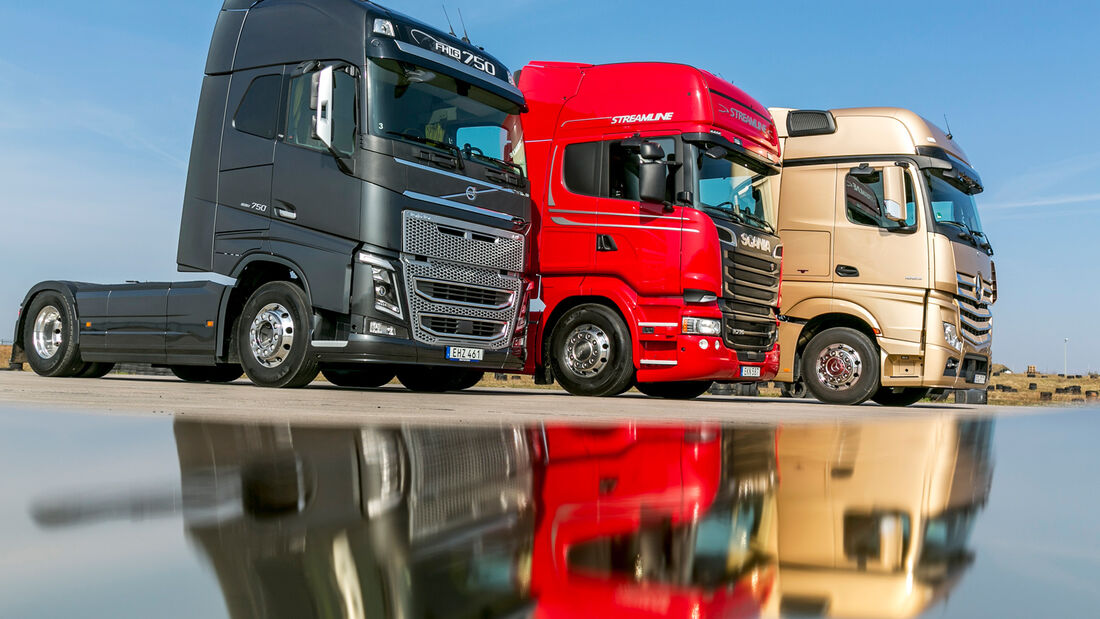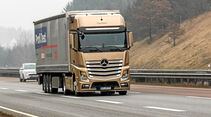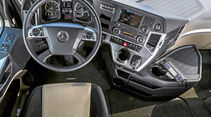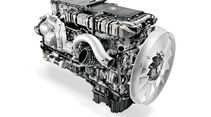It´s a world of difference in Formula One racing but amounts to nothing in day-to-day trucking: the Volvo FH16-750´s lead over the Scania R730 after one day of driving and a total of 455.4 kilometers on the test route is 35 seconds. nevertheless wanted to know which European tractor could claim the pole position for itself, and pitted the two Swedes and the currently most powerful Mercedes Actros against each other in a match of strength. When it comes to the standard power output for 40-ton trucks, particularly the Scania R730 and the Volvo FH16-750 play in an entirely different league. By comparison, the Mercedes Actros 1863 seems almost feeble at first glance.
The question of why the most powerful trucks traditionally come from Sweden cannot be answered definitively. Some say it´s the gross vehicle weight of up to 60 tons. Others say its the competition between Volvo and Scania. The second group is probably right. After all, the two Swedish manufacturers have been outdoing each other in terms of power ever since the late sixties. This period saw the first Scania V8 with 350 hp and 126 kpm of torque. Its competitor was named the Volvo F89; it had an output of 330 hp but one kpm more torque. It was therefore difficult to answer the question of which one was stronger. The Scania had more power; the Volvo had more torque. Over the ensuing years, Volvo was ahead, then Scania, then Volvo again, etc.
Scania remains just behind Volvo
The current situation seems to be clear: 730 hp and 3,500 Nm are the benchmarks of the 16.4-liter Scania eight-cylinder engine. The 16.1-liter Volvo D16K six-cylinder engine delivers 750 hp and 3,550 Nm. The fact that Scania hasn´t matched Volvo yet seems to be a matter of reason. 730 hp is plenty of power, even though 800 hp would have been easily attainable. Despite the marginally lower power, Scania is betting on the image of the sole remaining V8 in the world of commercial vehicles. The company even intends to elevate the V8 to cult status through its own publication, entitled Legend, which bears the subheading The V8 Magazine from Scania.
The first TD162 from Volvo in the eighties was just as unparalleled as Scania's V8 is today. Six huge cylinders measuring 2.7 liters each, for a total displacement of 16.12 liters, and an incredibly long stroke of over 165 millimeters made the large six-cylinder engine an exceptional phenomenon over many years. Both V8 engines and in-line six cylinder engines have their advantages and drawbacks. A V8 is certainly unnecessary in this power class today—unless image matters. By contrast, an in-line six-cylinder engine of this size plays the role of a universal world engine, which is why not only Volvo but also Mercedes now rely on in-line six-cylinder engines.
Actros is not outclassed, despite considerably less power
The question now is whether Mercedes´ most powerful engine, the 15.6-liter, 625-hp OM473 LA, can hold its own in this match of strength. The answer is not quite, but almost. It lacks at least 500 Nm of torque compared to the Volvo FH16 and the Scania R730, which also becomes apparent in the low rev range with a deficit of just under 100 hp. Another problem is the high overall gear ratio, which targets only 1,130 rpm at a speed of 85 km/h. With 2.336 and 2.402, respectively, Scania and Volvo use even higher (faster) axle ratios which, particularly in the case of Scania, lend the truck a ludicrous theoretical top speed of 150 km/h at 1,900 rpm.
However, particularly on hilly and slightly mountainous terrain, the Actros compensates for its lack of power with reduced Eco-roll phases and sparing use of PPC. Furthermore, this Actros doesn´t even feature an Eco program tailored to exceptionally low consumption—it is designed almost exclusively with performance in mind. The results on a stretch of the test route selected for its suitability for evaluating predictive cruise control systems and Eco-roll even document that, at 86.0 km/h, the Mercedes is the fastest of the three—but also the thirstiest, with a consumption of 26.38 liters. Scania´s consumption-minimizing electronic assistants skillfully ensure almost one liter less consumption at a speed of 85.3 km/h. A similar speed results with I-See in the Volvo; the consumption is roughly in between that of the Mercedes and the Scania.
The Mercedes Actros 1863 is entirely in its element on terrain of medium difficulty, so the much more powerful Swedes can by no means outclass it. Quite the opposite: the Actros performs well here, economically transporting goods somewhat faster than the Volvo and the Scania. Only when the incline exceeds around four percent does the truck from Stuttgart have to bow to the superiority of the clearly more powerful Swedes.
1000 point test route ensures comparability
In order to compare the consumption and speed of the three most powerful European semi-trailer tractors, made use of the 1000 point test route in south western Germany. Light traffic, hilly stretches on the highways and a lack of no-passing zones for trucks (only exception: the long downhill stretch to the Moseltal interchange) predestine the route for measurements of this type. In other words, these are ideal conditions that are rarely found in Germany but are fairly common in France or Spain.
Each of the three tractors had to complete three laps with different drivers and swapped semi-trailers. As the predictive cruise control systems behave very differently, 85 km/h was defined as the cruising speed, 80 km/h as the lower limit and 90 km/h as the upper limit. With few exceptions, the test drivers left the shifting to the automated twelve-speed gearboxes. This driving procedure was dictated mainly by the Volvo, because its I-See system  permits exactly 80 km/h as the lower limit when 85 km/h is set on the cruise control. The Scania would let the speed drop to 75 km/h in Eco mode; the speed decreases to 80 km/h in standard driving mode. With the Mercedes, the downward deviation is freely selectable in steps of one km/h. The driving procedure described above was therefore the only common denominator.
Systems operate quite differently
Practical experience shows that the three systems—PPC in the Mercedes, CCAP in the Scania and I-See in the Volvo–operate very differently despite identical benchmarks. We already wrote about the 1863 being in its element. The same can be said about the Scania R730, given its talent for manipulating momentum to minimize consumption. The verdict for the Volvo FH16 is mixed. I-See does not work with topographical data. Instead, it operates by consulting a central computer for stored empirical data from other vehicles that have already covered the corresponding route. Whatever the reason may be, the FH16 often shifts into eleventh gear in places where twelfth gear would be adequate. This ultimately results in 50 percent more shifts on incline than is the case for the Scania, which has a higher gear ratio. The Mercedes, which has almost the same gear ratio but is significantly less powerful, shifts another 50 percent more frequently.
Although the Actros confidently keeps pace up to an incline of four percent, it starts lagging behind at the latest when the incline reaches five percent. It still climbs such an incline at almost 79 km/h, but the Scania (87.7 km/h) and the Volvo (88.3 km/h) visibly leave it behind. The trucks are pretty much equal downhill, though. The engine brakes in the Mercedes (480 kW at 2,300 rpm) and the Volvo (470 kW at 2,200 rpm) are more than powerful enough to allow the truck to roll downhill safely at just under 90 km/h. Although the Scania´s engine brake is rated at 320 kW, it receives strong support from the company´s retarder.
Mercedes is only a few minutes slower
Ultimately, a speed difference clearly remains between the Mercedes on the one hand and the Volvo and Scania on the other hand at the end of the 455-kilometer test route. The two Swedes go into the lead exclusively on the long five and six percent grades, but they lose some of this lead again on easy terrain with long Eco-roll phases. The final result is 318.22 minutes for the Mercedes and 316.47 minutes for the Scania, which takes the already mentioned 35 seconds longer than the Volvo.
The Mercedes plays its trump card when it comes to consumption. This is not necessarily the case at low load on an easy route—the Scania is at least as good here—but rather at full load on inclines. The example here is the almost ten-kilometer-long, five percent climb from the Moseltal interchange towards Saarbrücken. The Mercedes consumes 105.54 liters/100 kilometers on average here, the Scania burns 111.25 liters/100 km in its eight cylinders and, with 115.53 liters/100 km, the Volvo takes a sip more. Part of the extra consumption is naturally due to the high speed, because aerodynamic drag also plays a role on inclines. The Volvo figuratively flies up the grade at almost 90 km/h, and the Mercedes drives just under 80 km/h. The Volvo is followed closely by the R730, which loses its 35-second lead to the Volvo on this and the other inclines.
Mercedes triumphs thanks to turbo compound
Turbo compound´ is the name of the technology that enormously benefits the full-load consumption of the Actros. The 15.6-liter OM473LA mobilizes around 50 hp via a second turbine acting on the crankshaft. In terms of energy, this extra power is free and becomes available in increasing amounts as the temperature of exhaust gases leaving the engine increases. Such a turbo-compound engine is therefore ideally suited for uphill driving at full throttle.
The level of driving comfort was not a criterion in this test, but it is very high in all three trucks. There are clear differences in the interior noise, however. Scania and Volvo are at a similar low level, with the Scania slightly edging out the Volvo. Measured in dB(A), the Mercedes is considerably louder. The higher noise level is not too disruptive, however. The wind noises from the high roof are more annoying.
Drawbacks shared by all three tractors include the limited payload, the high purchase price and the higher consumption. Tractors rated at around 450 hp are 400 to 600 kilograms lighter, cost 30,000 to 40,000 euro less and are more economical by 1.5 to 3 liters/100 kilometers.
Scania: best compromise between power and consumption
So, which is the fastest in the entire country? The answer is clear: the Volvo FH16-750. It drinks deeply to deliver its enormous speed, though. The part-load consumption on flat and hilly routes is OK, but this truck consumes noticeably more than the Scania and much more than the Mercedes at full load. Thanks in part to the turbo-compound technology, the Mercedes Actros 1863 LS is the most economical of the power trucks while still being remarkably fast. The Scania R730 manages to achieve the best compromise between consumption and driving performance. It is close to the Mercedes in terms of consumption and very close to the Volvo when it comes to speed. And another thing is clear: all three are clearly underchallenged with 40 tons.










